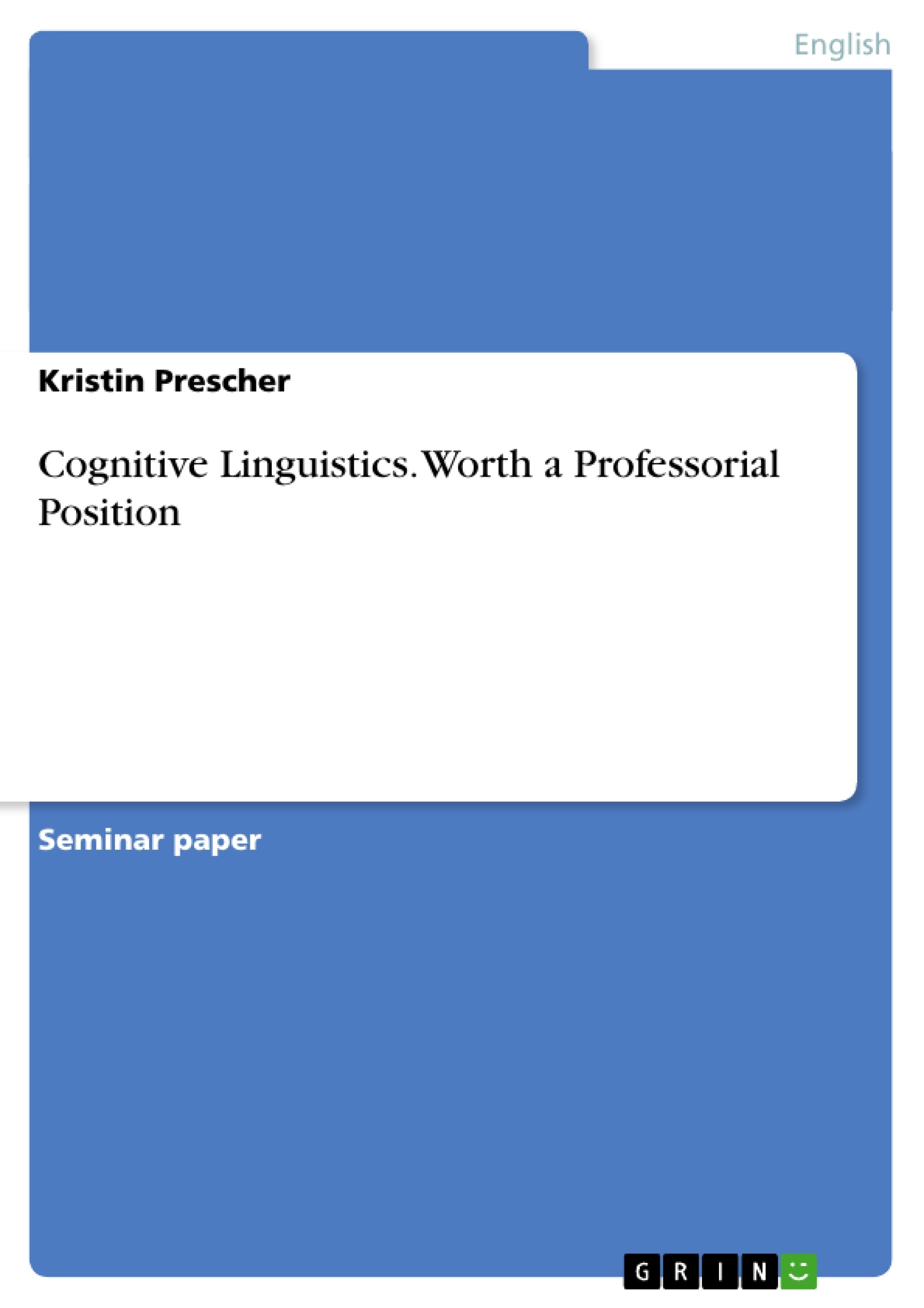The aim of this paper is to give a brief overview of the core ideas, approaches
and the main representatives of Cognitive Linguistics and in which way this
approach differs from the classical structuralistic view. The explanations will not be
exhaustive at all, but should suffice to make clear how revolutionary the ideas of
Cognitive Linguistics are and how it will hopefully influence linguistics in general in
the future.
Cognitive Linguistics developed at the beginning of the 1980ies mainly in the
United States as a completely new approach to the study of language and mind and
how these two are related. According to cognitive linguist Gilles FAUCONNIER
"perhaps for the first time a genuine science of meaning construction and its
dynamics has been launched"1. The representatives see language as one of the most
significant characteristics of cognitive activities and therefore the aim is to describe
and explain mental structures and processes which are important to the processing of
human language. According to Gilles FAUCONNIER, language is only the "tip of a
cognitive iceberg"2.
How does this view differ from the theories represented by structural
linguistics?
1 Gilles FAUCONNIER in: Theo JANSSEN & Gisela REDEKER (ed.): Cognitive Linguistics: Foundations,
Scope, and Methodology (1999: 96). Translation: "(…) wahrscheinlich erstmalig ist eine echte
Wissenschaft der Konstruktion von Bedeutungen und ihrer Dynamik in Gang gekommen (...)".
2 Gilles FAUCONNIER in: JANSSEN/ REDEKER (1999: 96). Translation: [Sprache ist nur] "die Spitze des
kognitiven Eisbergs".
Inhaltsverzeichnis (Table of Contents)
- Introduction
- The traditional view
- Categorization and Prototypes
- Categorization
- The Classical Approach
- Family Resemblance
- Colour Categorization
- Prototypes
- Basic Level Categories
- Conceptual metaphors and Cognitive Models
- Conceptual metaphors
- Image schemas
- Frames and Scripts
- Conclusion
- Summary
Zielsetzung und Themenschwerpunkte (Objectives and Key Themes)
This paper offers a concise overview of the central concepts, methodologies, and key figures associated with Cognitive Linguistics. The paper aims to highlight the distinctive features of this approach compared to traditional structuralist perspectives, emphasizing its revolutionary nature and potential impact on the broader field of linguistics. It aims to explain how the ideas of Cognitive Linguistics challenge conventional linguistic theories and suggest future directions for the study of language.
- The relationship between language and cognition
- The nature of meaning and how it is constructed
- The role of categorization and prototypes in understanding language
- The impact of conceptual metaphors and cognitive models on language use
- The differences between Cognitive Linguistics and traditional structuralist approaches
Zusammenfassung der Kapitel (Chapter Summaries)
- Introduction: This chapter introduces Cognitive Linguistics as a novel approach to the study of language and mind, emphasizing its focus on mental structures and processes involved in language processing. It contrasts this approach with traditional structuralist views and highlights the revolutionary nature of cognitive linguistic concepts.
- The traditional view: This chapter examines the shortcomings of traditional linguistic theories, such as the classical approach to feature analysis, the assumption of language autonomy and compositionality, and the arbitrariness of linguistic meaning. It critiques the structuralist perspective, particularly as exemplified by Ferdinand de Saussure, and its emphasis on language as a self-contained system of relationships between sounds and meanings.
- Categorization and Prototypes: This chapter delves into the concept of cognitive models and their role in structuring thought, highlighting how cognitive representations are stored in the mind and utilized in reasoning and categorization. It explores the inadequacy of the classical view of categorization and introduces alternative frameworks based on principles of cognitive processing.
- Conceptual metaphors and Cognitive Models: This chapter examines the concept of conceptual metaphors and their role in shaping language use and understanding. It explores how conceptual metaphors are based on experiential knowledge and influence our understanding of abstract concepts, as well as the connection between conceptual metaphors and cognitive models.
- Frames and Scripts: This chapter discusses the frameworks of frames and scripts as cognitive models that help organize and process information. It explores how these frameworks contribute to our understanding of meaning and how they interact with other cognitive structures.
Schlüsselwörter (Keywords)
Cognitive Linguistics, language and mind, meaning construction, categorization, prototypes, conceptual metaphors, cognitive models, frames, scripts, structuralism, language autonomy, compositionality, arbitrariness of meaning, feature analysis.
- Quote paper
- Kristin Prescher (Author), 2002, Cognitive Linguistics. Worth a Professorial Position, Munich, GRIN Verlag, https://www.hausarbeiten.de/document/17872


